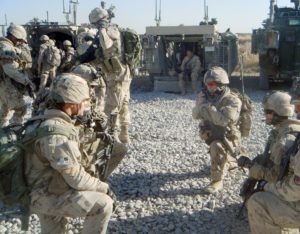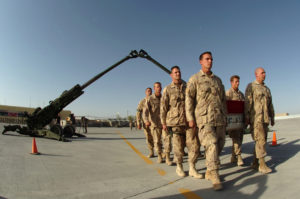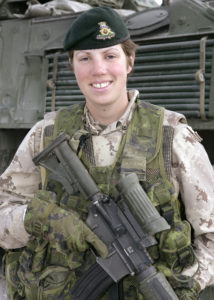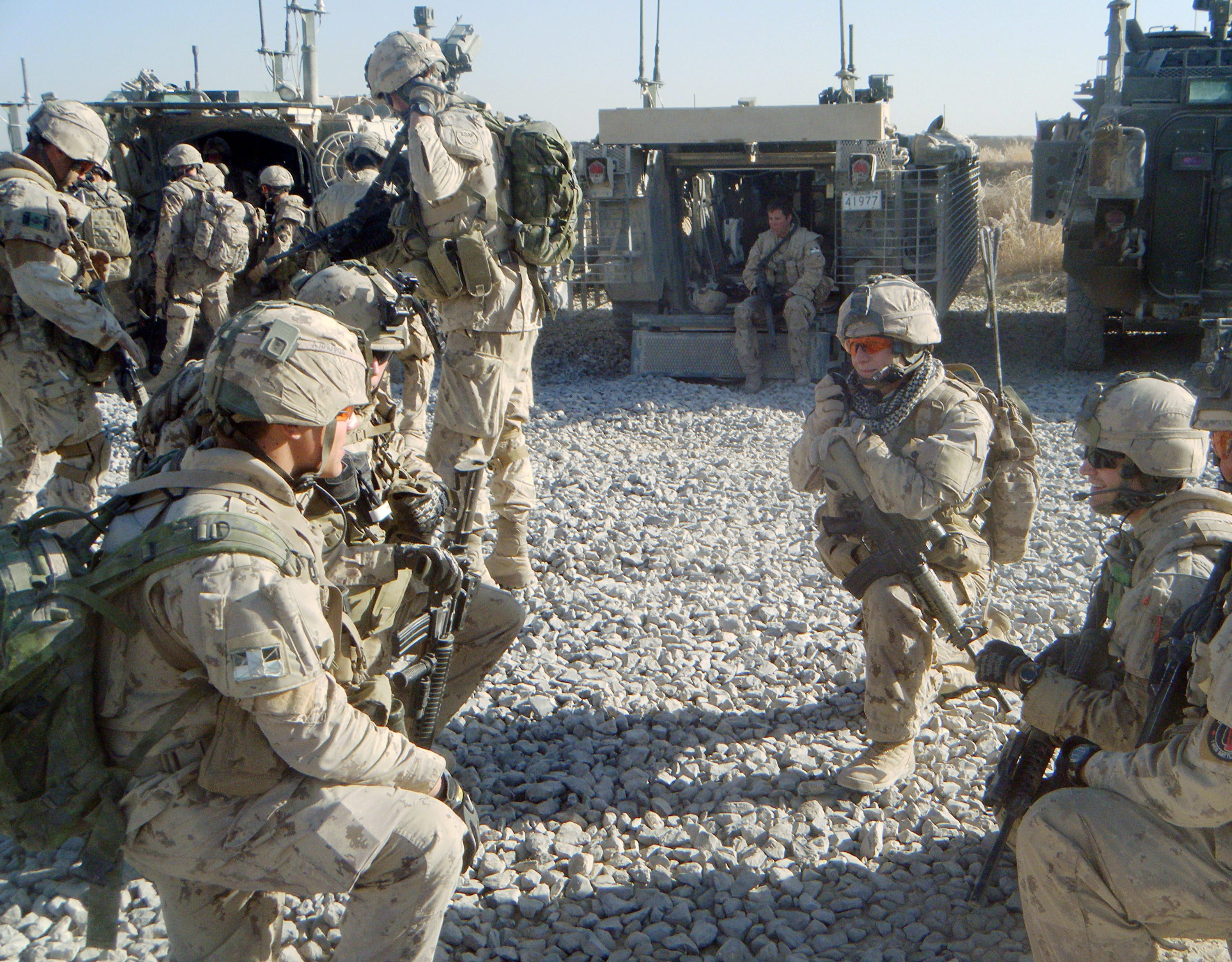
The Canadian Forces have only recently allowed women to enter its toughest and most dangerous professions: combat arms. Meet some who have tackled the challenge and excelled.
By Levon Sevunts
Reader’s Digest
April 2007
Lt. Chantal Tétreault stood in the crew commander’s hatch of her Bison light armoured vehicle surveying the dusty road ahead. She gripped the handle of a loaded machine gun, ready to fire. From hatches behind her, two Canadian soldiers scanned the nearby fields and the village’s mudcaked walls, their fingers tense on the trigger guards of their rifles.
The Bison had suddenly developed a flat tire. One of the soldiers could see a shiny steel spike stuck in the huge tire. Was this part of an ambush or just plain bad luck? Tétreault, a troop commander with the 23rd Field Squadron 2nd Combat Engineer Regiment, had to know. The vehicle was laden with enough high-powered plastic explosives to vaporize everybody inside the vehicle – and destroy the Afghan village around it – should a roadside bomb or an anti-tank rocket set them off.
The flat happened as Tétreault, 23, was leading the troop to an explosives range in the rugged mountains about 20 kilometres south of Kabul. It was a trip they took almost every week to destroy hundreds and thousands of kilograms of old munitions and unexploded ordinance, the legacy of 23 years of non-stop war. The lieutenant quickly posted sentries around the disabled convoy as curious Afghan villagers started gathering around them. It was hard to say what attracted them more: the sight of the broken-down Bison or the young woman in combat fatigues, a pistol strapped to her hip, ordering around men twice her size.
Although women soldiers have become a common sight in the armies of most Western nations, Tétreault and about 200 women of Canada’s regular forces are a breed apart. They have chosen the most difficult and dangerous military professions: the combat arms trades.
Women soldiers were traditionally given jobs in which they’d be less likely to face combat, such as nurses, clerks or signals specialists. Not anymore. With the advances in gender equality, they have been admitted into military occupations in which they may kill or be killed. All but one Canadian Forces occupations were opened to women in 1989; the submarine service remained closed to them until 2000.
When Maj. Dee Brasseur joined Canadian Forces in 1972, she wanted to be a physical-education officer, but that job was closed to women. A native of Pembroke, Ont., Brasseur started out as an administration clerk in a military dental office in Winnipeg. But filling out forms wasn’t what Brasseur had in mind as a rewarding career, so she applied to train as an air-weapons controller . With the Cold War in full swing, this would be as close to the action as she could be.
In late 1970s, the Canadian Forces initiated a study on women in nontraditional environments and roles, and went looking for volunteers for the fighter pilot program. Brasseur was accepted into it in 1979. She graduated a year and a half later, worked as a flight instructor in Moose Jaw, Sask., and in 1988 graduated from the basic fighter-pilot course. A year later, she became on of the two women in the world to pilot the CF-18 Hornet.
Brasseur so enjoyed her military career that she returned as a reservist after retiring in 1994, following an illustrious career that earned her the Order of Canada. She is now a staff officer in the directorate of air strategic planning at the National Defence Headquarters.
One day in early June 2005 in the large army tent at Camp Julien, Canada’s former base in Kabul, Capt. Angus Matheson, an expert on the Soviet occupation of Afghanistan, was giving a presentation about Soviet tactics of convoy protection on the road from Kabul to Kandahar. Capt. Lesley Kerckhoff , 27, listened carefully: She was to assist in planning the details of moving Canada’s base along this route, the hornet’s nest of Taliban insurgency in southern Afghanistan, to Kandahar.
The shy girl from Manitoulin Island, on Lake Huron, had come a long way since joining the military. She had enrolled in the Royal Military College in Kingston because her education would be paid for. She signed up for infantry, unaware that it was one of the toughest of all combat trades.
“When I first started my basic training, there were ten women signed up for infantry,” she says as gunfire cracks from the nearby range. “After that year in school there was just me left.”
Those women who tough it out to graduation must sometimes learn to employ a delicate, diplomatic touch. A triathlete with almost boundless stamina, Capt. Lisa Haveman was ready for the physical challenges of her military career — she trained as an artillery officer — but nothing had prepared her for negotiating gender roles in Afghanistan’s most conservative province. As the adjutant of the commander of the Canadian Provincial Reconstruction Team (PRT) in Kandahar, Haveman’s had to interact with local officials and tribal leaders, some of whom have firm ideas about where a woman’s place is. She couldn’t even talk to some Afghan men unless she spoke through a male soldier.
One evening Haveman was master of ceremonies as the American 107th Engineering Battallion transferred authority over the PRT to the Canadian contingent. Along with ensuring the event ran smoothly, she greeted dignitaries, offered them refreshments and guided them to their seats. Since greeting important guests is the prerogative of the master of the house in much of Central Asia and the Middle East, most of the Afghan journalists made an assumption: News bulletins that night announced the commander of the Canadian PRT was a woman.
The poise and grace with which Haveman conducted the ceremony also caught the eye of Kandahar governor’s chief of staff. At a dinner hosted that night by the governor at his residence, to which a number of Canadians were invited, a Canadian journalist noticed that the official kept looking at Haveman and smiling. “You’re quite intrigued with her, aren’t you?” he asked. The Afhan said that he was.
“He said that he had never had seen someone so wonderful and wanted to know if US$3,000 would be enough to have me,” Haveman recalls, laughing. “I guess it’s kind of flattering.”
Longueuil, Quebec native Chantal Tétreault that like her male counterparts at the Royal Military College, she had to earn the respect of her soldiers.
“When I first got in front of my troop, a little woman of five foot three, I had to show that I am as good as they are,” says Tétreault. “So I brought them on PT (physical training) and I killed everybody – including myself, but they didn’t know that. Then we went on a rucksack march and I showed them that I can carry my own stuff. So it took a bit longer but I had to show that I can do the job. And when you prove that, you don’t have any more problems.”
What matters the most now is that she’s been accepted as an equal member of the team, and serving in a combat situation with her soldiers has confirmed she made the right career choice. Even the daily news reports of attacks on Canadian soldiers don’t deter her. “This is what I wanted to do; I wanted to lead soldiers overseas. And I think at the end of the day what every soldier wants is to get into a combat situation and do the job.”
As the sun rose over Kandahar on May 19, 2006, thousands of troops lined the tarmac at the Kandahar air base. Soldiers from several countries stood at attention, their long shadows frozen over the gray concrete. An eerie calm settled over the usually busy base. Then a single armoured vehicle rolled onto the tarmac. A flag-draped casket lay in the back. Inside it were the remains of Capt. Nichola Goddard, the first Canadian female combat soldier killed in battle. Bagpipes wailed the lament.

“Go forth upon your journey Nichola,” said one of Canadian padres as eight members of her unit, the 1st Royal Canadian Horse Artillery Regiment, based in Shilo, Man., picked up the casket. Holding back tears, the soldiers carried the casket underneath an arch formed by two howitzers and between the ranks of soldiers, then up into the cavernous belly of a military transport plane for the flight home to Canada.
Goddard was a brilliant artillerist. She served as a forward-observation officer, which means it was her job to be in the heat of battle and call artillery fire, attack helicopters and jet fighters to support troops fighting on the ground.
“Nicky did this better than anybody that I’ve ever seen, ever,” Lt.-Col. Ian Hope, Goddard’s commander on the ground in Afghanistan, told reporters the news of her death reached the Kandahar airbase. “She was technically perfect at it, coupled with the fact that she had a voice that could calm you down in stress – she never lost her cool. And she was in the thick of it in the past two months.”
Goddard, who joined the military after graduating from high school, arrived in Kandahar in February 2006 on a six-months deployment. In letters home, she showed she’d had plenty of opportunities to prove that she could go toe to toe with the toughest of her male colleagues. In one e-mail, she wrote that her proudest moment was a ten-kilometre march with a 600-metre altitude gain, carrying about 60 kilograms of kit. She told her parents how the interpreter spoke with some local men who were watching her. The interpreter said to her, “Please excuse their staring. They are just very surprised that you are a woman working with all of these men. I have told them that you climbed over the mountain with us with your heavy bag and that you had no problems. They think that you must be very strong. I explained to them that you are just like the men, a that you can do everything that they can do.”

On May 17 her unit was returning from an operation to rout Taliban militants when it was ambushed in a village street. Three rocket-propelled grenades struck the LAV III vehicle she was riding in, and she was hit by shrapnel in the back of her neck. It was her father’s birthday.
This letter, written on her 26th birthday arrived after her death. It may speak for all the other women who choose combat careers:
May 2, 2006
Dear Mum and Dad,
The days seem to move along at their own pace. Some days fly by, and others creep along. We are officially at the half-way point now, though, I can’t believe that I’ve been here for 3 months. In some ways, it feels like I’ve been here forever. In others, as if I just got here. I am sort of getting used to things, I guess. I try to remind myself to appreciate every experience – even the ones I don’t really enjoy 🙂
I have been thinking a lot about fate lately. It was such an accident of birth that we ended up where we did when we did, that we are where we are now, with the choices that we have available to us. It seems to me that we have such a burden of responsibility to make the world a better place for those who were born into far worse circumstances. It is more than donating money to charities – it is taking action and trying to make things better. You have both shown me that throughout my life – but here, I realize it more than ever before.
My current job and role in Afghanistan is part of that – but it is more the non-governmental organizations that come later. They are the ones that really make the difference. I like to think that my being here means they will be able to come that much sooner, and operate more freely. I will be looking for more opportunities to volunteer in Wainwright and to really try to make a difference. It is very humbling to be here, part of something so much bigger than myself.
Love always,
Nichola
